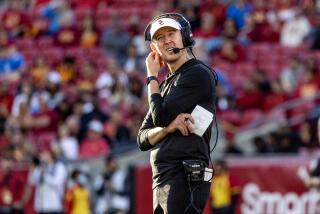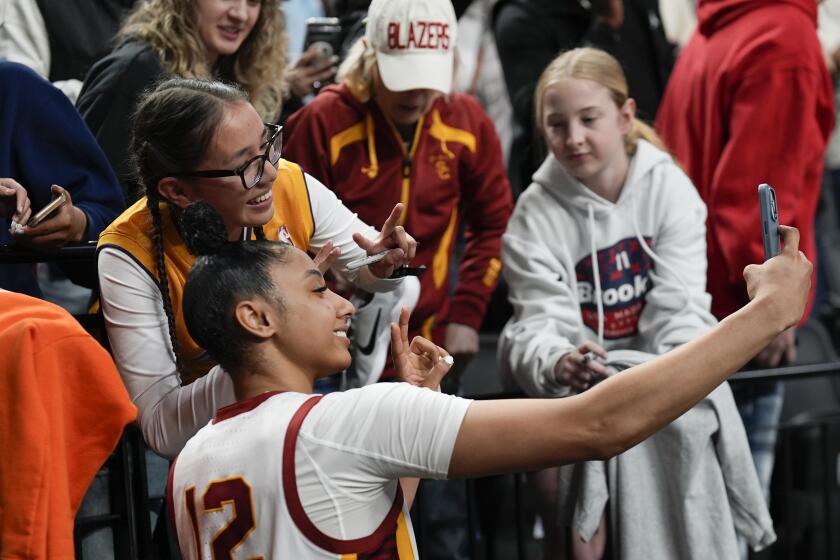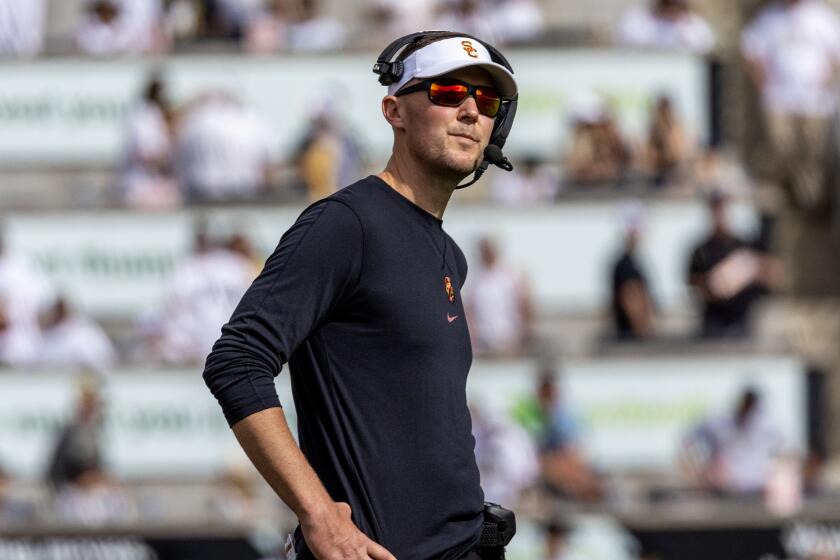USC looking to stick with reclaimed smash-mouth style against Texas

USC reprised a classic late in the third quarter of its opener two weeks ago. With two men in the backfield, the Trojans’ center and right guard pulled to the left side, forming the core of a phalanx of blockers. The running back swept in behind them.
USC was essentially running John McKay’s offensive staple, student-body right — only to the left.
“In honor to Coach McKay, that’ll never leave the playbook,” Trojans coach Clay Helton said.
It didn’t work out very well. A defensive lineman penetrated before center Nico Falah could get in position, and the defender gobbled up Velus Jones in the backfield. The play lost seven yards.
USC found more success with its own, updated scheme the next week against Stanford.
The Trojans’ running game torched the Cardinal, bullies of the Pac-12 Conference for the past decade, for 307 yards. USC’s offense lost yards on just one, non-kneel-down play, a one-yard sack of quarterback Sam Darnold. It was a dominant showing.
USC did not run the big, lumbering, student-body-right offenses of teams past, but offensive coordinator Tee Martin, who occasionally digs up film of games and practices from Pete Carroll’s tenure as coach, said the Trojans’ offense had a throwback look.
“It looked like USC football,” Martin said. “It looked like how USC football should look.”
In addition to all the other compelling story lines — the reprisal of the classic 2006 Rose Bowl, the matchup of two of college football’s most storied programs and USC’s quest for the playoffs — Saturday’s game against Texas also will provide some clarity on USC’s identity.
Is USC back to being the ferocious running team of the past? Or was Stanford’s defensive line just not that great?
In two games under new coach Tom Herman, Texas has put up plenty of points. Behind a pair of hulking running backs, the Longhorns have almost 49 points per game.
Defense was the problem in a loss to Maryland. But its front has three starters who average 295 pounds, and all are juniors or older.
USC’s coaching staff thinks it can pound the ball against such a front. It thinks it can pound the ball against any front. Martin began the Stanford game by calling four straight runs and rushes on six of the first seven plays.
Helton said the intent was to establish the team’s identity early.
“Those are the times when you impose your will as a team and as an offensive line,” guard Viane Talamaivao said. “It’s just a great feeling.”
If the goal is the same one USC sought for decades, the methods have changed. Instead of overloading defenses with blockers, USC exploits mismatches. Darnold’s potent arm keeps the secondary from creeping in. Players set in motion neutralize outside defenders. A read-option or a run-pass option can serve as a virtual blocker without requiring a lineman. Once the defense is spread thin, USC’s offensive linemen can dominate individual matchups.
At least that’s the plan. Dominating individual matchups has been the tricky part.
Against Stanford, the linemen did. On one block that sprung Stephen Carr for a 52-yard run, guard Chris Brown drove a defender back more than five yards. With motion that occupied the defensive back and a tight end’s seal block, Carr was left with a hole wider than most studio apartments.
“I had no idea it was that large,” said tackle Toa Lobendahn, who was supposed to help on Brown’s block but was not needed. “Seeing the picture of what they posted was just crazy.”
Stanford’s coach, David Shaw, sounded awed.
“Their offensive line played extremely well,” Shaw said. “They ran the ball very well. I thought we ran it pretty well, and they ran it better than we did tonight. And I’m not used to saying things like that.”
USC’s task now is to make that an every-week occurrence.
USC’s defense also will be tested against the Longhorns. The Trojans have given up an average of almost 217 rushing yards in two games. And Texas is the most dangerous offense USC will see in its early-season schedule.
Herman’s teams usually stay balanced between rushing and passing. But USC found its rushing success can pay dividends. Because USC can eat up the clock, opposing teams turn one-dimensional when they fall behind.
Martin said in his play-calling he would keep riding the offensive line, as he did against Stanford.
“I’m always looking at the running game,” Martin said. “My whole thing is all about the running game. So I want to feel that way after every game.”
Follow Zach Helfand on Twitter @zhelfand
More to Read
Go beyond the scoreboard
Get the latest on L.A.'s teams in the daily Sports Report newsletter.
You may occasionally receive promotional content from the Los Angeles Times.







